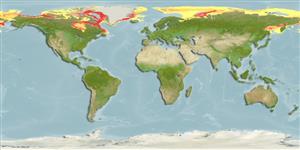Environment: milieu / climate zone / depth range / distribution range
Ecologia
marinhas demersal; intervalo de profundidade 5 - 1038 m (Ref. 117245). Polar; 84°N - 50°N, 180°W - 180°E (Ref. 117245)
Arctic to Northwest Atlantic and Northwest Pacific: Canadian Arctic to Hudson Bay, Ungava Bay and Labrador in Canada (Ref. 7251). Arctic Ocean, Barents Sea, Franz Josef Land, Spitsbergen, eastern Greenland, Kara, Laptev, Siberian and Chukchi seas and the Sea of Okhotsk.
Tamanho / Peso / Idade
Maturity: Lm ? range ? - ? cm
Max length : 10.0 cm SL macho/indeterminado; (Ref. 4701)
Descrição breve
Chaves de identificação | Morfologia | Morfometria
Espinhos dorsais (total) : 7; Raios dorsais moles (total) : 11 - 13. Caudal fin rounded. Dorsal fin spines not visible (Ref. 4379). Olive, darker dorsally (Ref. 4379).
Found on mud, gravel or stone bottoms at temperatures below 0° C (Ref. 4701). Young occur in shallower water (Ref. 4701). Benthic; feed on crustaceans and oikopleura (Ref. 58426).
Life cycle and mating behavior
Maturities | Reprodução | Spawnings | Egg(s) | Fecundities | Larvas
Stein, D.L., 1986. Cyclopteridae. p. 1269-1274. In P.J.P. Whitehead, M.-L. Bauchot, J.-C. Hureau, J. Nielsen and E. Tortonese (eds.) Fishes of the North-eastern Atlantic and the Mediterranean. UNESCO, Paris. Vol. III. (Ref. 4701)
Categoria na Lista Vermelha da IUCN (Ref. 130435)
Ameaça para o homem
Harmless
Utilização humana
Ferramentas
Relatórios especiais
Descarregue XML
Fontes da internet
Estimates based on models
Preferred temperature (Ref.
123201): -1.2 - 2.9, mean 0.2 °C (based on 2662 cells).
Phylogenetic diversity index (Ref.
82804): PD
50 = 0.5000 [Uniqueness, from 0.5 = low to 2.0 = high].
Bayesian length-weight: a=0.02089 (0.00774 - 0.05639), b=3.03 (2.79 - 3.27), in cm total length, based on LWR estimates for this (Sub)family-body shape (Ref.
93245).
Nível Trófico (Ref.
69278): 3.3 ±0.34 se; based on food items.
Resiliência (Ref.
120179): Médio, tempo mínimo de duplicação da população 1,4 - 4,4 anos (Fecundity assumed < 1000).
Fishing Vulnerability (Ref.
59153): Low vulnerability (10 of 100).
